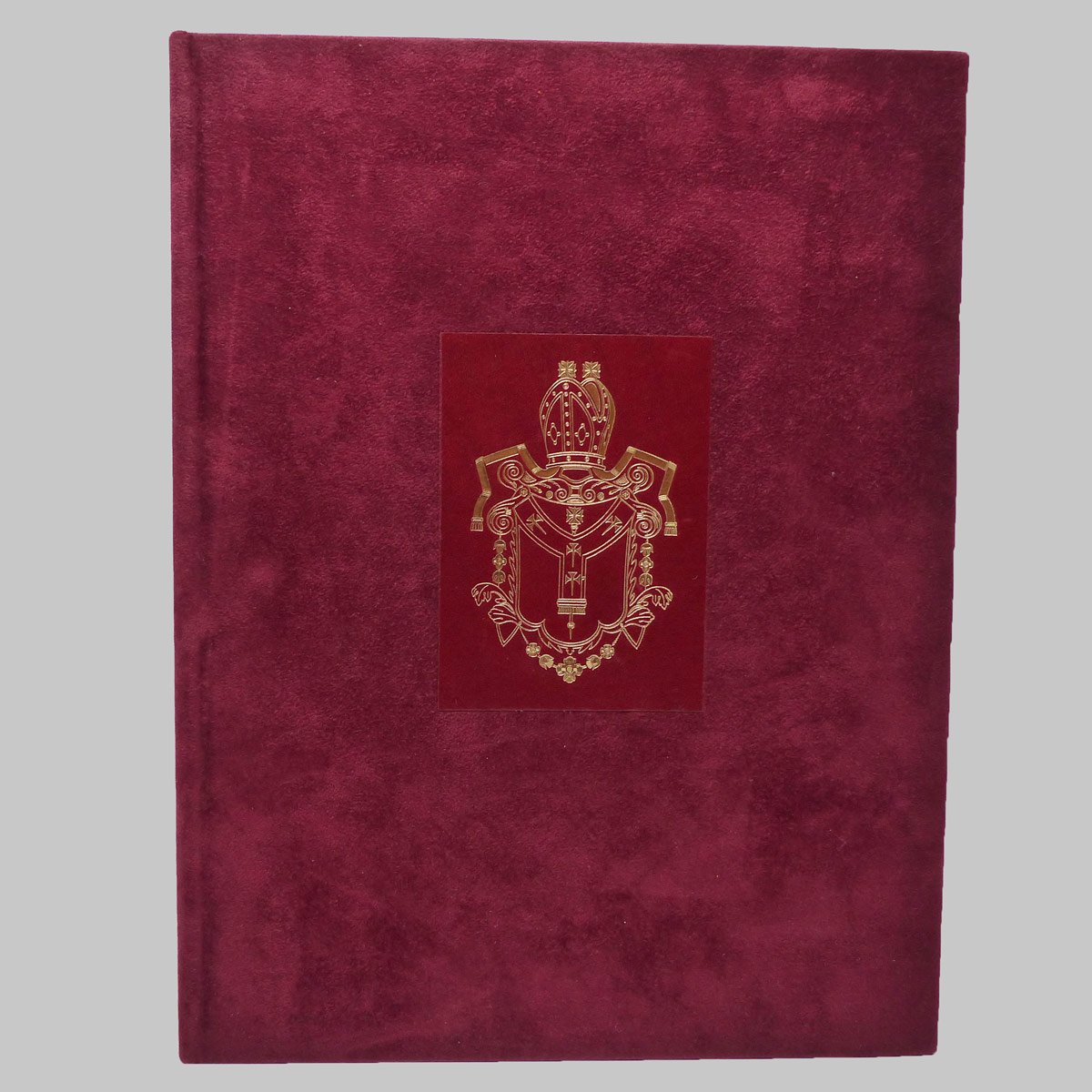 Image 1 of 7
Image 1 of 7

 Image 2 of 7
Image 2 of 7

 Image 3 of 7
Image 3 of 7

 Image 4 of 7
Image 4 of 7

 Image 5 of 7
Image 5 of 7

 Image 6 of 7
Image 6 of 7

 Image 7 of 7
Image 7 of 7








The Lambeth Apocalypse. Manuscript 209 in Lambeth Palace Library. A Limited Edition.
A Critical Study by Nigel Morgan.
A Limited Edition, 1 of 550 copies produced, 2 Volumes, housed within presentation burgundy velvet drop back box. Published by Harvey Miller (London), 1990.
Volume 1: Quarto, pp 112. 78 half-page painted and gilded miniatures with additional illuminated decoration and initial letters, and 28 full-page coloured drawings of the Life of St John, Miracles of the Virgin Mary and other religious subjects; reproduced from photographic images of the original manuscript by James Austin of Cambridge. Bound in maroon morocco by Buchbinderei Richard Mayer of Stuttgart; raised bands, Lambeth Palace library armorial crest to upper board, metal corner pieces and clasps.
Commentary volume: Quarto, pp 383, plate section to end consisting of 222 monochrome images of Comparative Illustrations of Apocalypse Scenes in the Metz, Lambeth and Gulbenkian Manucripts, and 72 monochrome figures. Bound in quarter maroon morocco with black cloth-covered boards, maroon label with gilt titles, and border to upper board.
A fine example of this magnificent production.
The original manuscript was written between 1260 and 1264 in London. Eleanor de Quincy (circa 1230-1274), a lay lady of the English aristocracy, is believed to be the client, from heraldic evidence in the illustrations.
According to the Lambeth Palace Library:
"This spectacular manuscript is a richly illustrated text of the Book of Revelation, accompanied by a theological commentary. Created in the thirteenth century, the work describes the events leading up to the Last Judgment and the triumph of the righteous over evil. The manuscript was produced for Lady Eleanor de Quincey (d. 1274), Countess of Winchester. It is a striking visual example of the piety of many medieval aristocratic women, and of the role they played in the patronage of scribes and illuminators.
We see here an earthquake shaking the ground, while the sun turns black and the moon the colour of blood; all ranks of people hide themselves in caves to avoid the wrath of God (Revelation 6:12-15)."
Please contact us for shipping costs if ordering from outside the UK.
A Critical Study by Nigel Morgan.
A Limited Edition, 1 of 550 copies produced, 2 Volumes, housed within presentation burgundy velvet drop back box. Published by Harvey Miller (London), 1990.
Volume 1: Quarto, pp 112. 78 half-page painted and gilded miniatures with additional illuminated decoration and initial letters, and 28 full-page coloured drawings of the Life of St John, Miracles of the Virgin Mary and other religious subjects; reproduced from photographic images of the original manuscript by James Austin of Cambridge. Bound in maroon morocco by Buchbinderei Richard Mayer of Stuttgart; raised bands, Lambeth Palace library armorial crest to upper board, metal corner pieces and clasps.
Commentary volume: Quarto, pp 383, plate section to end consisting of 222 monochrome images of Comparative Illustrations of Apocalypse Scenes in the Metz, Lambeth and Gulbenkian Manucripts, and 72 monochrome figures. Bound in quarter maroon morocco with black cloth-covered boards, maroon label with gilt titles, and border to upper board.
A fine example of this magnificent production.
The original manuscript was written between 1260 and 1264 in London. Eleanor de Quincy (circa 1230-1274), a lay lady of the English aristocracy, is believed to be the client, from heraldic evidence in the illustrations.
According to the Lambeth Palace Library:
"This spectacular manuscript is a richly illustrated text of the Book of Revelation, accompanied by a theological commentary. Created in the thirteenth century, the work describes the events leading up to the Last Judgment and the triumph of the righteous over evil. The manuscript was produced for Lady Eleanor de Quincey (d. 1274), Countess of Winchester. It is a striking visual example of the piety of many medieval aristocratic women, and of the role they played in the patronage of scribes and illuminators.
We see here an earthquake shaking the ground, while the sun turns black and the moon the colour of blood; all ranks of people hide themselves in caves to avoid the wrath of God (Revelation 6:12-15)."
Please contact us for shipping costs if ordering from outside the UK.
A Critical Study by Nigel Morgan.
A Limited Edition, 1 of 550 copies produced, 2 Volumes, housed within presentation burgundy velvet drop back box. Published by Harvey Miller (London), 1990.
Volume 1: Quarto, pp 112. 78 half-page painted and gilded miniatures with additional illuminated decoration and initial letters, and 28 full-page coloured drawings of the Life of St John, Miracles of the Virgin Mary and other religious subjects; reproduced from photographic images of the original manuscript by James Austin of Cambridge. Bound in maroon morocco by Buchbinderei Richard Mayer of Stuttgart; raised bands, Lambeth Palace library armorial crest to upper board, metal corner pieces and clasps.
Commentary volume: Quarto, pp 383, plate section to end consisting of 222 monochrome images of Comparative Illustrations of Apocalypse Scenes in the Metz, Lambeth and Gulbenkian Manucripts, and 72 monochrome figures. Bound in quarter maroon morocco with black cloth-covered boards, maroon label with gilt titles, and border to upper board.
A fine example of this magnificent production.
The original manuscript was written between 1260 and 1264 in London. Eleanor de Quincy (circa 1230-1274), a lay lady of the English aristocracy, is believed to be the client, from heraldic evidence in the illustrations.
According to the Lambeth Palace Library:
"This spectacular manuscript is a richly illustrated text of the Book of Revelation, accompanied by a theological commentary. Created in the thirteenth century, the work describes the events leading up to the Last Judgment and the triumph of the righteous over evil. The manuscript was produced for Lady Eleanor de Quincey (d. 1274), Countess of Winchester. It is a striking visual example of the piety of many medieval aristocratic women, and of the role they played in the patronage of scribes and illuminators.
We see here an earthquake shaking the ground, while the sun turns black and the moon the colour of blood; all ranks of people hide themselves in caves to avoid the wrath of God (Revelation 6:12-15)."
Please contact us for shipping costs if ordering from outside the UK.
